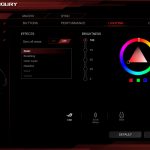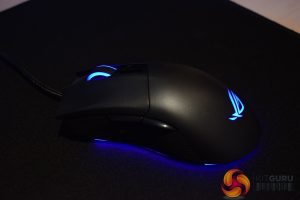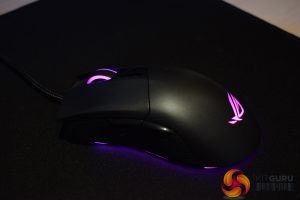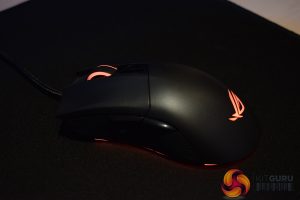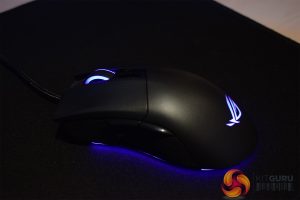To test the Gladius II, I used it as my daily driver for nearly two weeks, giving me plenty of time to get an idea for how it feels and performs. During this time, I used it while performing a variety of different tasks, including gaming, photo editing and general usage.
First, let's take a look at the ROG Armoury software.
Above you can see a small gallery of the 6 different pages that are available within the Armoury software. All-in-all, the software is very good and it gives you control over all the key areas like button assignment, DPI stages and RGB lighting.
However, there are just a couple of minor things I want to mention. First, you can only set two DPI stages per profile. This is a bit disappointing as I personally use 4 different stages on a daily basis, so having this limited to just two is a bit frustrating.
Secondly, I can't help but feel Razer Synapse (in my opinion, the best software suite around at the minute) is a bit more nuanced and intricate. For example, Synapse gives you lots of additional information about your mouse, including movement heatmaps, mouse clicks and distance travelled stats, while its lighting control is also a bit more comprehensive. Armoury is far from bad – in fact, it is a good piece of software – but I don't think it is quite the complete package yet. Admittedly, this is to be expected considering Razer has been in the peripheral market a lot longer than ROG, but it is still worth mentioning.
That being said, one feature in the Gladius II's favour is its support for Aura Sync, which lets you sync the RGB lighting across multiple ASUS and ROG products. Sadly, I don't have anything else Aura-compatible on-hand, but I've seen it work before with the Claymore and Spatha peripherals, and it really looks great.
Speaking of the RGB lighting, this is one area where the Gladius II gets the upper-hand over the DeathAdder Elite. The colours are vibrant and accurate, while brightness uniformity is very good. However, the star of the show is undoubtedly the underglow effect, as it looks amazing and really lights up your desk well. I would expect many other peripheral manufacturers to follow-suit and start implementing similar ‘underglow' lighting solutions, it really is that good.
Anyway, let's move on to the physical testing of the Gladius II.
I'll start by mentioning the comfort of the mouse. It is a very well-designed piece of kit in this regard, as I found it fits my hand very well and provides great support for either palm or claw grips. I particularly appreciate the contoured mouse buttons, as my fingers fit perfectly in the small grooves.
It is also worth talking about the weight of the Gladius II, as this mouse weighs in at 110g (not including the cable). Super-hardcore FPS gamers may think this is too heavy, but for me, it is pretty much perfect – it still allows fast movements, but it also feels sturdy and solid in your hand.
Elsewhere, it is good to see the addition of the sniper button on the mouse's left-hand side. This button is perfectly positioned for your thumb to press without stretching and it is definitely a good feature to have. If you find it getting in your way, it can also be disabled using the Armoury software – but I enjoyed using it while gaming.
As I mentioned above, one of my issues with the Gladius II is the lack of DPI stages. I make use of 4 different stages on a daily basis (two low-res stages for Photoshop, one for gaming and one for general Windows use) so this limit is annoying. You can set different DPI stages for each of the 3 profiles, but this means you will have to switching between profiles and DPI stages on a regular basis to use more than two different stages. In an ideal world, the Gladius II would support multiple DPI stages per profile while having two dedicated DPI buttons (one for stepping up, one for stepping down). As it stands, the current limit of 2 stages per profile – which admittedly could be a non-issue for some people – is the biggest problem I have with this mouse.
I also want to talk a bit about the different switches. I swapped out one of the original switches and replaced it with one of the spares, that way allowing me to compare the two switch types side-by-side. The differences are definitely very subtle, but I do feel that the spare switches are a bit faster and lighter – the original switches have slightly heavier tactile feedback, which just makes them feel slightly slower. The differences are still very small, but it is definitely worth trying out the switches to see what you prefer. In any case, it is great to have this level of customisation available to end-users.
Lastly, it is no surprise that I had no issues tracking while using the Gladius II. The Pixart PMW 3360 sensor is a class unit, and one that I have used in plenty of different mice with no issues previously. It is capable of reaching up to 12000 DPI, and whether I was using it at 400 or 4000 DPI, it was pixel-perfect throughout my testing.
Be sure to check out our sponsors store EKWB here
 KitGuru KitGuru.net – Tech News | Hardware News | Hardware Reviews | IOS | Mobile | Gaming | Graphics Cards
KitGuru KitGuru.net – Tech News | Hardware News | Hardware Reviews | IOS | Mobile | Gaming | Graphics Cards




